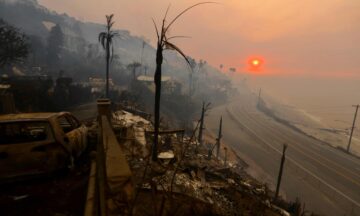Rebecca Solnit in The Guardian:
 It was only last month that the Franklin fire, fanned by the dry Santa Ana winds from the east gusting up to 50 miles an hour, burned 4,000 acres around Malibu in 48 hours. The Station fire burned 160,577 acres in 2009 to set the record as LA’s largest and the Woolsey fire in 2018 burned 96,949 acres and destroyed 1,643 structures, while the 1970 Malibu fire destroyed 31,000 acres, incinerated hundreds of structures, and killed 10 people, fed in part by six months of no rain. Los Angeles has a history of catastrophic fire.
It was only last month that the Franklin fire, fanned by the dry Santa Ana winds from the east gusting up to 50 miles an hour, burned 4,000 acres around Malibu in 48 hours. The Station fire burned 160,577 acres in 2009 to set the record as LA’s largest and the Woolsey fire in 2018 burned 96,949 acres and destroyed 1,643 structures, while the 1970 Malibu fire destroyed 31,000 acres, incinerated hundreds of structures, and killed 10 people, fed in part by six months of no rain. Los Angeles has a history of catastrophic fire.
As Mike Davis, in his bluntly titled 1998 essay The Case for Letting Malibu Burn, noted: “Malibu, meanwhile, is the wildfire capital of North America and, possibly, the world. Fire here has a relentless staccato rhythm, syncopated by landslides and floods. The rugged 22-mile-long coastline is scourged, on the average, by a large fire (one thousand acres plus) every two and a half years, and the entire surface area of the western Santa Monica Mountains has been burnt three times over the twentieth century.” The case for letting Malibu burn is that it is inevitably going to burn, over and over, but fire departments protect structures as long as they can.
None of these facts make what is happening now less terrible. And it is terrible – to me personally as well; people I know have lost not just their homes but their neighborhoods; friends and family have had to evacuate not knowing if they’ll have homes to return to. But these facts do perhaps make it all less surprising.
More here.
Enjoying the content on 3QD? Help keep us going by donating now.
